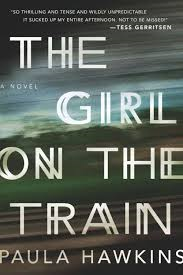
Review by Michelle Palmer
Rachel Watson, the main character in Paula Hawkins’ The Girl on the Train, rides the same train every morning and night, staring absently into the windows and lives of the people she sees in the houses along the way. Over time, one couple in particular has captured her interest—Rachel names them “Jason and Jess,” and they live down the street from where Rachel herself lived before her life began to deteriorate. Dubbed by Rachel as “the golden couple,” Jason and Jess seem to have the perfect life, at least from the tiny glimpses Rachel has each day.
One day, Rachel sees “Jess” in the arms of another man, causing Rachel to question everything she thought was true about the perfect couple; matters only get worse, when Jess, whose real life name is Megan, turns up missing. What has before been a mindless fantasy during Rachel’s commute now becomes full-blown obsession, and Rachel quickly finds herself part of the growing mystery of Megan’s disappearance. Rachel’s life, which had been a downward spiral of alcoholism and self destruction, now suddenly has purpose.
Hawkins’ skillfully crafted twists and turns make this thriller a worthy read, but it’s Rachel who is the real star. Rachel’s addiction problems begin after her struggle with infertility and, as her marriage to husband Tom falls apart, Rachel finds solace through alcohol. As the book opens, she has lost her job, her marriage, and her home. In her shame, Rachel pretends to go to work each day in London, comforted by her cans of gin and tonic. With her many flaws, Rachel is a sort of anti-heroine. She spends much of the novel trying to claw her way toward sobriety, and her relapses and frequent blackouts make her an incredibly unreliable narrator, adding an additional layer of mystery to the novel. Despite that, or perhaps because of it, we root for her, and we can’t help but hope each time Rachel vows to become sober that this drink will be her last.
Part Hitchcock’s Rear Window and part Gone Girl, The Girl on the Train will keep you turning the pages late into the right, cautiously peering around the corner for the next clue. Hawkins’ pacing and skilled foreshadowing lend a sense of doom to the entire novel, filled with characters who are all deeply flawed, but The Girl on the Train is a compulsively readable mystery with a thrilling conclusion. Rachel and her fellow cast of characters will remain with you long after the final page.












